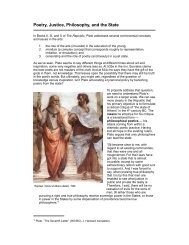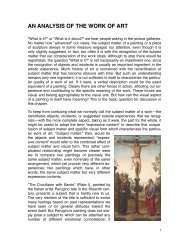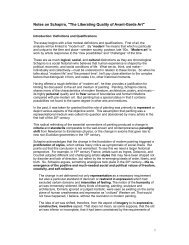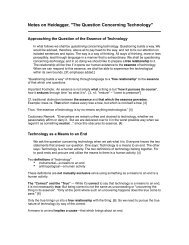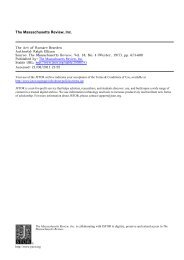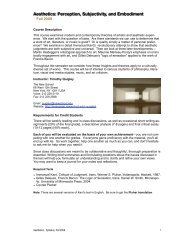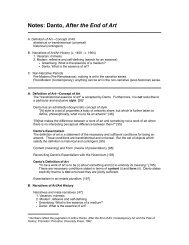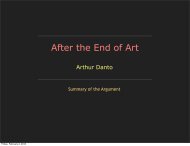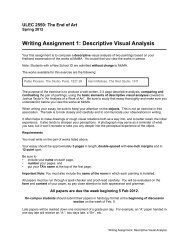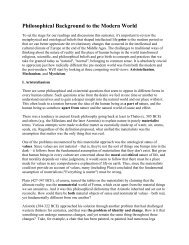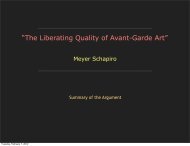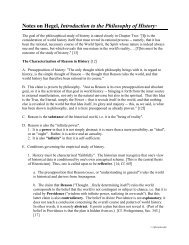“A thing or person of the samekind or category as another.”This paragraph seems to developthe notion of intersubjectivity in anadmittedly indirect manner.M-P argues for the autonomy ofthe painter.general, must return to the "there is" which precedes it; to the site, the soil of the sensible<strong>and</strong> humanly modified world such as it is in our lives <strong>and</strong> for our bodies—not thatpossible body which we may legitimately think of as an information machine but thisactual body I call mine, this sentinel st<strong>and</strong>ing quietly at the comm<strong>and</strong> of my words <strong>and</strong>my acts. Further, associated bodies must be revived along with my body—"others," notmerely as my congeners, as the zoologist says, but others who haunt me <strong>and</strong> whom Ihaunt; "others" along with whom I haunt a single, present, <strong>and</strong> actual Being as no animalever haunted those of his own species, territory, or habitat. In this primordial historicity,science's agile <strong>and</strong> improvisatory thought will learn to ground itself upon thingsthemselves <strong>and</strong> upon itself, <strong>and</strong> will once more become philosophy….Now art, especially painting, draws upon this fabric of brute meaning whichoperationalism would prefer to ignore. Art <strong>and</strong> only art does so in full innocence. From thewriter <strong>and</strong> the philosopher, in contrast, we want opinions <strong>and</strong> advice. We will not allowthem to hold the world suspended. We want them to take a st<strong>and</strong>; they cannot waive theresponsibilities of humans who speak. Music, at the other extreme, is too far on the hitherside of the world <strong>and</strong> the designatable to depict anything but certain schemata of Being—its ebb <strong>and</strong> flow, its growth, its upheavals, its turbulence.Only the painter is entitled to look at everything without being obliged to appraise what hesees. For the painter, we might say, the watchwords of knowledge <strong>and</strong> action lose theirmeaning <strong>and</strong> force. Political regimes which denounce "degenerate" painting rarelydestroy paintings. They hide them, <strong>and</strong> one senses here an element of "one neverknows" amounting almost to an acknowledgment. The reproach of escapism is seldomaimed at the painter; we do not hold it against Cézanne that he lived hidden away atL'Estaque during the Franco-Prussian War. And we recall with respect his "life isfrightening," although the most insignificant student, after Nietzsche, would flatly rejectphilosophy if he or she were told that it did not teach us how to live life to the fullest. It isas if in the painter's calling there were some urgency above all other claims on him.Strong or frail in life, but incontestably sovereign in his rumination of the world,possessed of no other "technique" than the skill his eyes <strong>and</strong> h<strong>and</strong>s discover in seeing<strong>and</strong> painting, he gives himself entirely to drawing from the world—with its din of history'sglories <strong>and</strong> sc<strong>and</strong>als—canvases which will hardly add to the angers or the hopes ofhumanity; <strong>and</strong> no one complains. [2] What, then, is the secret science which he has orwhich he seeks? That dimension which lets Van Gogh say he must go "still further"?What is this fundamental of painting, perhaps of all culture?IIOn the “intertwining” or “chiasm”:“The...[term] indicates his newconception of the body, as a 'chiasm'or crossing-over (the term comesfrom the Greek letter chi) whichcombines subjective experience <strong>and</strong>objective existence. His term for thisnew conception of the body is'flesh' (chair) <strong>and</strong> he insists that it isan 'ultimate notion; a 'concreteemblem of a general manner ofbeing; which provides access both tosubjective experience <strong>and</strong> objectiveexistence.”[Thomas Baldwin, Maurice Merleau-Ponty: Basic Writings, New York:Routledge, 2004.]The painter "takes his body with him," says Valery. Indeed we cannot imagine how a mindcould paint. It is by lending his body to the world that the artist changes the world intopaintings. To underst<strong>and</strong> these transubstantiations we must go back to the working,actual body—not the body as a chunk of space or a bundle of functions but that bodywhich is an intertwining of vision <strong>and</strong> movement.I have only to see something to know how to reach it <strong>and</strong> deal with it, even if I do notknow how this happens in the nervous system. My moving body makes a difference inthe visible world, being a part of it; that is why I can steer it through the visible. Moreover,it is also true that vision is attached to movement. We see only what we look at. Whatwould vision be without eye movement? And how could the movement of the eyes notblur things if movement were blind? If it were only a reflex? If it did not have its antennae,its clairvoyance? If vision were not prefigured in it?All my changes of place figure on principle in a corner of my l<strong>and</strong>scape; they are carriedover onto the map of the visible. Everything I see is on principle within my reach, at leastwithin reach of my sight, <strong>and</strong> is marked upon the map of the "I can." Each of the twomaps is complete. The visible world <strong>and</strong> the world of my motor projects are both total2
parts of the same Being.This extraordinary overlapping, which we never give enough thought to, forbids us toconceive of vision as an operation of thought that would set up before the mind a pictureor a representation of the world, a world of immanence <strong>and</strong> of ideality. Immersed in thevisible by his body, itself visible, the see-er does not appropriate what he sees; he merelyapproaches it by looking, he opens onto the world. And for its part, that world of which heis a part is not in itself, or matter. My movement is not a decision made by the mind, anabsolute doing which would decree, from the depths of a subjective retreat, some changeof place miraculously executed in extended space. It is the natural sequel to, <strong>and</strong>maturation of, vision. I say of a thing that it is moved; but my body moves itself; mymovement is self-moved. It is not ignorance of self, blind to itself; it radiates from a self….The “intertwining” again.The enigma derives from the fact that my body simultaneously sees <strong>and</strong> is seen. Thatwhich looks at all things can also look at itself <strong>and</strong> recognize, in what it sees, the "otherside" of its power of looking. It sees itself seeing; it touches itself touching; it is visible <strong>and</strong>sensitive for itself. It is a self, not by transparency, like thought, which never thinksanything except by assimilating it, constituting it, transforming it into thought—but a selfby confusion, narcissism, inherence of the see-er in the seen, the toucher in the touched,the feeler in the felt—a self, then, that is caught up in things, having a front <strong>and</strong> a back, apast <strong>and</strong> a future….This initial paradox cannot but produce others. Visible <strong>and</strong> mobile, my body is a thingamong things; it is one of them. It is caught in the fabric of the world, <strong>and</strong> its cohesion isthat of a thing. But because it moves itself <strong>and</strong> sees, it holds things in a circle arounditself.[3] Things are an annex or prolongation of itself; they are incrusted in its flesh, theyare part of its full definition; the world is made of the very stuff of the body. Thesereversals, these antinomies,[4] are different ways of saying that vision is caught or comesto be in things—in that place where something visible undertakes to see, becomes visibleto itself <strong>and</strong> in the sight of all things, in that place where there persists, like the originalsolution still present within crystal, the undividedness of the sensing <strong>and</strong> the sensed.“unbreakable”, “impenetrable”This interiority no more precedes the material arrangement of the human body than itresults from it. What if our eyes were made in such a way as to prevent our seeing anypart of our body, or some diabolical contraption were to let us move our h<strong>and</strong>s overthings, while preventing us from touching our own body? Or what if, like certain animals,we had lateral eyes with no cross-blending of visual fields? Such a body would not reflectitself; it would be an almost adamantine body, not really flesh, not really the body of ahuman being. There would be no humanity.But humanity is not produced as the effect of our articulations or by the way our eyes areimplanted in us (still less by the existence of mirrors, though they alone can make ourentire bodies visible to us). These contingencies <strong>and</strong> others like them, without whichmankind would not exist, do not by simple summation bring it about that there is a singleman. The body's animation is not the assemblage or juxtaposition of its parts. Nor is it aquestion of a mind or spirit coming down from somewhere else into an automation—which would still imply that the body itself is without an inside <strong>and</strong> without a "self." Ahuman body is present when, between the see-er <strong>and</strong> the visible, between touching <strong>and</strong>touched, between one eye <strong>and</strong> the other, between h<strong>and</strong> <strong>and</strong> h<strong>and</strong> a kind of crossoveroccurs, when the spark of the sensing/sensible is lit, when the fire starts to burn that willnot cease until some accident befalls the body, undoing what no accident would havesufficed to do….The intertwining is now brought tobear on painting.Once this strange system of exchanges is given, we find before us all the problems ofpainting. These problems illustrate the enigma of the body, which enigma in turnlegitimates them. Since things <strong>and</strong> my body are made of the same stuff, vision mustsomehow come about in them; or yet again, their manifest visibility must be repeated inthe body by a secret visibility. "Nature is on the inside," says Cézanne. Quality, light,3



